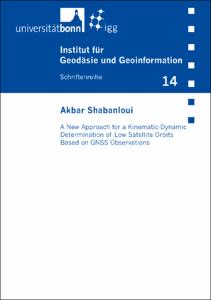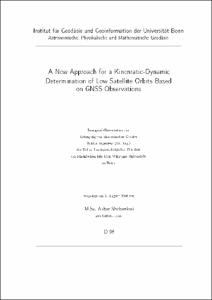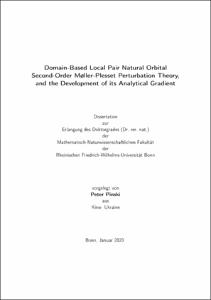Shabanloui, Akbar: A new approach for a kinematic-dynamic determination of low satellite orbits based on GNSS observations. - Bonn, 2008. - , . In: Schriftenreihe / Institut für Geodäsie und Geoinformation, 14.
Online-Ausgabe in bonndoc: https://hdl.handle.net/20.500.11811/1397
Online-Ausgabe in bonndoc: https://hdl.handle.net/20.500.11811/1397
@phdthesis{handle:20.500.11811/1397,
author = {{Akbar Shabanloui}},
title = {A new approach for a kinematic-dynamic determination of low satellite orbits based on GNSS observations},
school = {},
year = 2008,
series = {Schriftenreihe / Institut für Geodäsie und Geoinformation},
volume = 14,
note = {A new approach for the integrated kinematical-dynamical orbit determination of low flying satellites based on high-low GPS-SST observations is proposed. These observations are code and carrier phase measurements between a Low Earth Orbiter (LEO) and the satellites of any of the Global Navigation Satellite Systems (GNSS) such as GPS, GLONASS or in future GALILEO. The orbit determination in this investigation is restricted to short arcs. The orbit determination technique is characterized by the fact that the satellite’s arcs are represented by a semi-analytical series, consisting of a linear combination of the boundary vectors of the satellite’s arc, a linear combination of Euler and Bernoulli polynomials up to a specific upper degree and a sine series up to a properly selected upper summation index. This kind of orbit representation does not only allow to determine arbitrary functionals of the satellite’s orbits, such as velocities and accelerations of the satellite, it covers also the possibility to introduce geometrical and kinematical as well as dynamical observables for the determination of the orbit parameters. Furthermore, besides a pure kinematical orbit determination it is possible to introduce dynamical force function restrictions to realize a reduced-kinematical orbit determination – or in case of restricting each free orbit parameter – a pure dynamical orbit determination. The accuracy of the orbit representation depends primarily on the quality of the GPS-SST observation accuracy, the GPS satellite configuration and the number of GPS satellites at every individual observation epoch. The orbit determination approach has been tested based on simulation data sets and with real GPS observations of the satellite CHAMP. The proposed integrated kinematical-dynamical orbit determination opens a wide field of applications such as the orbit determination of satellite formation flight configurations and its application for the Earth system research.},
url = {https://hdl.handle.net/20.500.11811/1397}
}
author = {{Akbar Shabanloui}},
title = {A new approach for a kinematic-dynamic determination of low satellite orbits based on GNSS observations},
school = {},
year = 2008,
series = {Schriftenreihe / Institut für Geodäsie und Geoinformation},
volume = 14,
note = {A new approach for the integrated kinematical-dynamical orbit determination of low flying satellites based on high-low GPS-SST observations is proposed. These observations are code and carrier phase measurements between a Low Earth Orbiter (LEO) and the satellites of any of the Global Navigation Satellite Systems (GNSS) such as GPS, GLONASS or in future GALILEO. The orbit determination in this investigation is restricted to short arcs. The orbit determination technique is characterized by the fact that the satellite’s arcs are represented by a semi-analytical series, consisting of a linear combination of the boundary vectors of the satellite’s arc, a linear combination of Euler and Bernoulli polynomials up to a specific upper degree and a sine series up to a properly selected upper summation index. This kind of orbit representation does not only allow to determine arbitrary functionals of the satellite’s orbits, such as velocities and accelerations of the satellite, it covers also the possibility to introduce geometrical and kinematical as well as dynamical observables for the determination of the orbit parameters. Furthermore, besides a pure kinematical orbit determination it is possible to introduce dynamical force function restrictions to realize a reduced-kinematical orbit determination – or in case of restricting each free orbit parameter – a pure dynamical orbit determination. The accuracy of the orbit representation depends primarily on the quality of the GPS-SST observation accuracy, the GPS satellite configuration and the number of GPS satellites at every individual observation epoch. The orbit determination approach has been tested based on simulation data sets and with real GPS observations of the satellite CHAMP. The proposed integrated kinematical-dynamical orbit determination opens a wide field of applications such as the orbit determination of satellite formation flight configurations and its application for the Earth system research.},
url = {https://hdl.handle.net/20.500.11811/1397}
}









